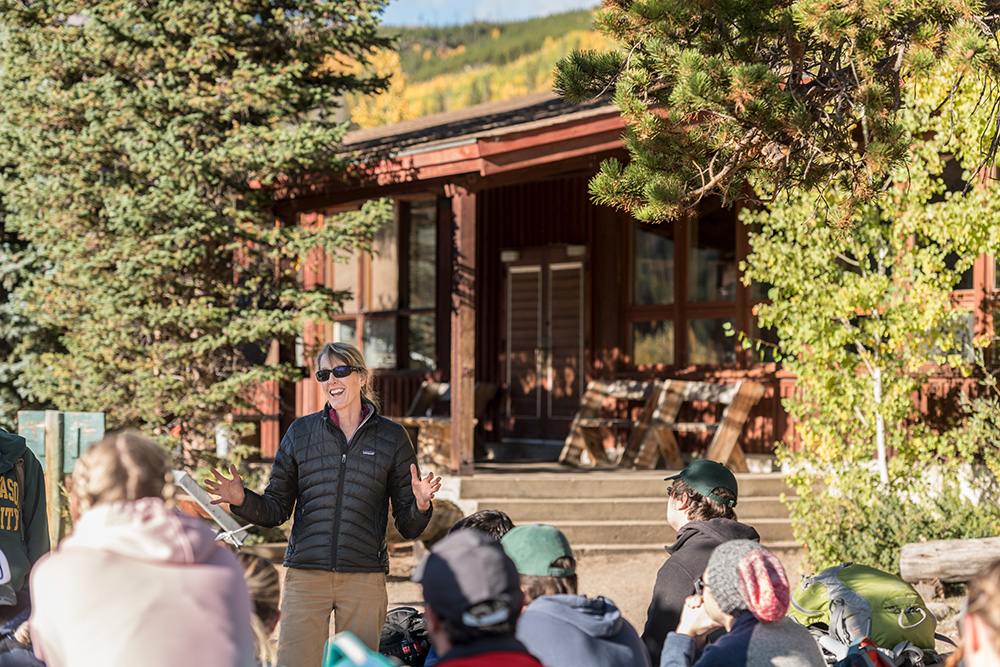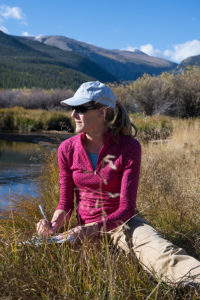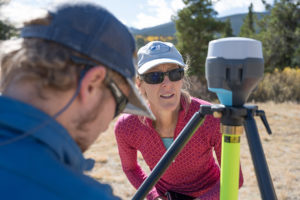
Sara Rathburn has always liked math, science, and being outdoors.
While trying to map her life’s course in college, she discovered it was possible to get paid to study rocks outside. She took her first job with the US Geological Survey working with geomorphologists, and she said, it “flipped on all the lights” for her: She is a professor of geosciences at Colorado State University who studies responses to disturbance episodes as well as to long-term changes under a warming climate.
“I am fascinated by rivers,” said Rathburn. “It is interdisciplinary work that involves studying the thin skin of Earth. Rivers integrate processes from the tops of ridges to the valley bottoms and form the physical template on which biological communities are built and chemical reactions occur.
“They are so much more than conduits for water and sediment,” she added. “They are complex, scientifically challenging and relevant ecosystems to study.”
‘Incredible mentor and teacher’
Annette Patton, who worked as a graduate student with Rathburn for five years studying landslides and now holds a post-doctoral position at the University of Oregon, describes her mentor as curious, engaged, and compassionate. All those qualities make Rathburn a talented scientist, she said, and an even better mentor.

“Her door is always open to students who need guidance, no matter the cause,” said Patton. “She managed to actively participate in conversations about how to move my research projects forward without compromising my agency in the project. Sometimes, after talking to her about a research question, Sara would come to me a day later to say that she had woken up in the middle of the night thinking about my questions. Those moments demonstrated to me how much Sara cares about her students.”
Mentorship is important for Rathburn, who received the Warner College of Natural Resources’ Mentorship Award in 2017. She credits her own success to numerous mentors she had as a young scientist.
She also adds, lightheartedly but seriously, that hearing the word “no” may not be the final answer. This is a philosophy she uses while empowering students to take the lead in their work. And she’s quick to say that watching students thrive and be successful on their own path is what’s most exciting for her.
Rathburn is also bringing new capacity for mentorship to CSU through her work facilitating workshops for the Center for Improvement of Mentorship Experiences in Research.
“Sara’s collegial engagement, research, teaching, and mentoring wonderfully embodies our department’s internationally recognized excellence in geomorphology,” said Rick Aster, professor of geophysics and head of the Geosciences Department at CSU.
Rathburn recently became a Fellow of the Geological Society of America. The prestigious designation recognizes her volunteer commitment to her division and honors her dedication to research and student success. She will be traveling to Iceland as a Fulbright Scholar in the fall of 2021 to study the influence of Iceland’s Forest Service afforestation efforts on river channel stability. She will work with University of Iceland and Forest Service colleagues to support efforts to reforest the country to combat landscape degradation challenges they face due to historic land-use patterns.
“I was very grateful for the opportunity to learn alongside Sara and discover new ideas with her,” said Patton. “It emphasized her ability to guide her students to learn for themselves. Because Sara is so eager to learn new ideas and apply knowledge from other fields, she models how to learn and grow as a scientist for her students. It is a rare and valuable skill for a mentor.”
Rathburn’s research
Patton, who worked so closely with Rathburn, perhaps best describes the work her mentor does.
“Sara’s primary expertise is studying how rivers respond to disturbance, like large sediment inputs during storms and landslides,” she said. “She and her students evaluate how sediment is delivered to rivers and reservoirs, how sediment behaves once it is in surface water, and how long the effects of that sediment persist. In recent years, she and I also began to examine the patterns of landslides occurrence to better understand how rock type, topography, and permafrost influence landslide initiation.”
Rathburn, along with others, has also been instrumental in revitalization of research infrastructure at the CSU Mountain Campus. She’s part of a group of faculty and researchers who have been steadily adding scientific instrumentation to the campus over the past few summers.

She and graduate student Christoph Suhr are assessing the valley in which the Mountain Campus is nestled to understand its natural history and evolution. The valley presents an interesting study, in that geomorphologists are still unclear how glacial valleys evolve and fill with sediment, like the valley where CSU students get to live and study part of the year.
The current maps of the area lack significant details about the area’s more recent geologic history since glaciers retreated from the valley some 11,000 years ago. Rathburn, Suhr, and Assistant Professor Dan McGrath (co-advising Suhr), are evaluating the area with ground penetrating radar, combined with information collected from above through drone flights to create a more detailed map of the campus.
These data will help understand the processes and rates of sediment accumulation forming the thick alluvium in the valley. The area’s alluvial deposits from former glaciers and the river are more than 10 meters deep. “We want to fully quantify the total depth of sediments, variability in grain sizes, and lateral extent of deposits,” said Rathburn.
Making an impact in students and society through science
Rathburn always has her waders ready for the river and her eye on student success, looking to a future where students become increasingly more excited about the potential for studying and working in the geosciences.
“The broader impact of my work investigates river system change over time to understand and mitigate human impacts and natural hazards, and to prepare the next generation of geoscientists to be confident, nimble thinkers to meet future natural resource challenges.” Rathburn said. “I am hopeful for a future where people make choices about land and water use that ensure river ecosystems are maintained.”